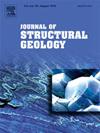裂谷结构与发育:冰岛北部克拉夫拉裂缝群
IF 2.6
2区 地球科学
Q2 GEOSCIENCES, MULTIDISCIPLINARY
引用次数: 0
摘要
了解裂谷演化对于地震和火山灾害评估非常重要,最近冰岛的堤坝事件就突出了这一点。我们通过ArcticDEM分析了构成N-S Krafla裂缝群(KFS)的2507个构造,12个原始正形图,源自历史航空照片和实地侦察。在1:5万比例尺上,确定并研究了323条喷发裂缝、1412条伸展裂缝、759条正断层和13条火山口边缘断层。构造显示,从克拉夫火山口向北和向南的强度减弱。断层滑动剖面主要是非对称的,显示出从火山口向外逐渐变细的累积偏移量。沿正断层切割后lgm单元测量的断层滑动率为0.06 ~ 6.55 mm/年,从克拉弗拉火山口向外减小。这些特征是由于岩脉从克拉弗拉岩浆房沿裂谷向两侧重复传播,岩脉尖端逐渐加深,岩脉随距离增加而减少和变薄的结果。沿裂谷不对称性表现为北伸展裂缝较多,南正断层较多,裂谷宽度从南平均7.5 km减小到北平均6 km,同一方向的扩张值从32.5 m减小到14 m。KFS受Krafla岩浆房突出岩脉的局部作用和区域应力场决定冰岛北部裂谷总体向北发展的双重作用。本文章由计算机程序翻译,如有差异,请以英文原文为准。
Rift structure and development: The Krafla Fissure Swarm (Northern Iceland)
Understanding rift evolution is important for seismic and volcanic hazard assessment, as highlighted by recent dyking events in Iceland. We analysed 2507 structures constituting the N-S Krafla Fissure Swarm (KFS) through the ArcticDEM, 12 original orthomosaics, derived from historical aerial photos, and field reconnaissance. At a scale of 1:50,000, we identified and studied 323 eruptive fissures, 1412 extension fractures, 759 normal faults, and 13 caldera rim faults. Structures show a decrease in intensity northward and southward from the Krafla Caldera. Fault slip profiles are predominantly asymmetric, showing cumulative offsets tapering outward from the caldera. Fault slip rates, measured along normal faults cutting post-LGM units, range from 0.06 to 6.55 mm/yr, and decrease outward from the Krafla Caldera. These patterns resulted from repeated dykes propagating laterally from the Krafla magma chamber along the rift, a gradual deepening of the dyke tip, and a lower occurrence and thinning of dykes with distance. An along-rift asymmetry is given by more abundant extension fractures in the northern portion of the KFS and more normal faults in its southern part, together with a decrease in rift width from an average of 7.5 km in the south to 6 km in the north, and a decrease of dilation values, from 32.5 m to 14 m in the same direction. The KFS is subject to a double process of rift development given by the local effect of dykes protruding from the Krafla magma chamber, and the regional stress field determining a general northward development of the rifts in northern Iceland.
求助全文
通过发布文献求助,成功后即可免费获取论文全文。
去求助
来源期刊

Journal of Structural Geology
地学-地球科学综合
CiteScore
6.00
自引率
19.40%
发文量
192
审稿时长
15.7 weeks
期刊介绍:
The Journal of Structural Geology publishes process-oriented investigations about structural geology using appropriate combinations of analog and digital field data, seismic reflection data, satellite-derived data, geometric analysis, kinematic analysis, laboratory experiments, computer visualizations, and analogue or numerical modelling on all scales. Contributions are encouraged to draw perspectives from rheology, rock mechanics, geophysics,metamorphism, sedimentology, petroleum geology, economic geology, geodynamics, planetary geology, tectonics and neotectonics to provide a more powerful understanding of deformation processes and systems. Given the visual nature of the discipline, supplementary materials that portray the data and analysis in 3-D or quasi 3-D manners, including the use of videos, and/or graphical abstracts can significantly strengthen the impact of contributions.
 求助内容:
求助内容: 应助结果提醒方式:
应助结果提醒方式:


